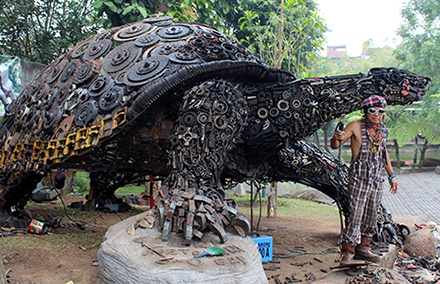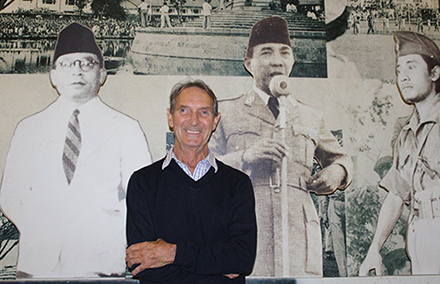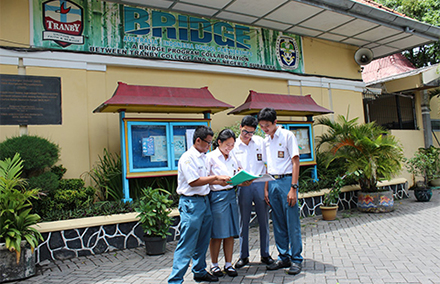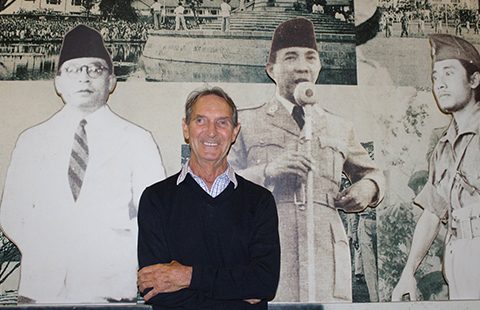
Indonesian metal sculptor Ono Gaf with his turtle in Batu, East Java. Photo by Duncan Graham.
Australia and Indonesia need to look beyond aid, trade and the barricade to deepen their relationship.
Last century American Senator William Fulbright, who founded the exceptional international exchange program that bears his name said:
In the long course of history, having people who understand your thought is much greater security than another submarine.
A few weeks ago academics William Maley and Bambang Nugroho wrote in The Jakarta Post that the way back to normality for Australia and Indonesia was through leadership of ‘skilled professionals’.
This has been a common theme since Australia’s Ambassador Paul Grigson was recalled following the executions of drug smugglers Andrew Chan and Myuran Sukumaran. Don’t fret, the argument runs, now the Ambassador is back in his Jakarta fortress the diplomats will get the Indonesia-Australia relationship back on the road again provided, as Prime Minister Tony Abbott says, journalists don’t get in the way.
This is a seriously flawed assumption.
Diplomats follow the policies of politicians who take their cues from the public mood. They can’t ‘lead’ anything. In fact, I think they helped get us into this mess by misreading the character and philosophy of Indonesia’s new President, the uncompassionate Joko ‘Jokowi’ Widodo.
The path forward won’t come from professionals in bombproof shelters but suburban folk seeing for themselves how their neighbors live, understanding their values and appreciating what’s really happening next door.
Five years ago former president Susilo Bambang Yudhoyono asked the Australian Parliament for a more constructive relationship, unaware our spies were eavesdropping on his wife Ani’s phone.
His words were described as ‘forthright and touching’, ‘transformative and moving’. His appeal inspired; fresh schemes followed, old ones blossomed. While officials pondered, individuals took action.
Among them was Perth journalist and historian Dr Frank Palmos who has done more than a talkfest of cultural attaches to improve our image in Indonesia. He’s achieved this by writing Sacred Territory, the definitive history of the Battle of Surabaya and then using his own money to have the book translated into Indonesian.
Around 5,000 copies should be released on 10 November, the 70th anniversary of that nation-defining event, and published by a major newspaper chain.
Palmos’ determination to help our neighbours get to know their real history instead of the one constructed by the late President Suharto has earned him enormous respect. Fortunately he’s not alone.

Dr Frank Palmos, author of a definitive history of the battle of Surabaya, stands in front of cut-outs of Hatta and Sukarno. Photo by Duncan Graham.
In 2010 former Western Australian Trade Commissioner Ross Taylor gathered a group of like-minded volunteers to start the Indonesia Institute offering an alternative tough-love voice to balance the constrained views of government. It’s become the go-to source for informed comment outside officialdom.
Retired social worker and public servant Peter Johnston initiated the Bamboo Micro Credit scheme in 2007 to offer interest-free loans to small entrepreneurs. It now lends millions of rupiah in three cities and is expanding as ordinary Australians donate small sums to fund the initiative.
There are many other examples – these are just ones I can vouch for personally. Never underestimate the power of a determined individual.
However a clear-eyed look at the official schemes show they’ve been too few and small for any deep and lasting impact.
Although Jokowi’s administration seems to have sidelined SBY’s hopes, both nations need to engage beyond the professionals’ issues of aid, trade and barricade. These are important, but they’re not the stuff of chats in the bus.
True friendship requires trust and the best way is through talking to people across the street, understanding their quirks and concerns, applauding their achievements, empathising with their difficulties.
It’s true in my kampong and your suburb; it’s true in our world.
The Australia-Indonesia Bridge School Partnership is a splendid project. It started seven years ago and funding ends this year. So far 112 schools have been involved along with more than 450 teachers. Certainly not to be rubbished. But put this in perspective; there are about 32 million primary students in Indonesia attending 150,000 schools.
The prestigious New Colombo Plan is another fine idea, this year helping 60 of Australia’s smartest undergraduates learn in locations throughout the Asia Pacific region. There are many other scholarships.
Top of the schemes has to be the Australian Consortium for In-Country Indonesian Studies driven by a small group of dedicated academics led by Murdoch University’s Professor David Hill. It’s been running for 20 years and has helped more than 1,600 undergraduates get to know their neighbours.
More than 900,000 Australians are studying at Australian tertiary institutions. Not all are interested in overseas cultural studies, or Indonesia. Let’s assume just one tenth of one per cent. That’s 900 – and ACICIS is handling 80 a year.
There are 11 Indonesians for every Australian so there’s a limit to how much one country can do. But on these figures Australia isn’t even coming within coo-ee of having meaningful contact on any scale.
Yet this worrying situation could be vastly and easily improved: Not through spending big money – but by eliminating barriers.

Indonesian students outside SMAN5 Surabaya – a school participating in the BRIDGE programme with Tranby College in Western Australia. Photo by Duncan Graham.
Australia has agreements with 31 nations to offer visas allowing young people to wander and work in Australia for up to a year. Many Australians will have met European and East Asian backpackers under this scheme and made lasting friendships. All now have a better appreciation of each other’s cultures.
Such encounters are not surprising as last year almost 240,000 visas were issued. They’re commonly known as Working Holiday visas – though the official term is Working Holiday Maker; to further confuse the situation there are two classes, Working Holiday class 417 and Work and Holiday class 462.
This latter group includes Indonesia and caps the number at 1,000. This visa requires applicants to have functional English, have completed two years undergraduate study and – these are the curly ones – possess A$ 5,000 [Rp 53 million] and ‘a letter of home government support’.
These restrictions do not apply to applicants from the Working Holiday class countries.
Last year only 436 Indonesians were successful. Anecdotally they find the financial and government approval fences too high to leap. The visa costs A$ 420 [Rp 4.4 million].
So the applicants Australia needs and who would benefit most, the smart but poor, the incandescent visionaries with no friends in Jakarta’s high places or fathers in the army, these kids aren’t getting to see the country next door and the chance to erase myths and hang-ups.
The visa scheme is reciprocal, but unbalanced. Eighteen months ago a seminar co-sponsored by the government-supported Australia Indonesia Youth Association heard that between 10 and 14 visas had been issued to young Australians, though many had applied. It seems the kids are keen, but the bureaucrats are not.
The irony is that these walls, topped by broken glass, have been built by governments saying they want more people-to-people contacts.
Tourism is supposed to expand the mind with rich experiences helping the traveller better comprehend the world’s complexities. To visit Australia Indonesians must answer 52 questions on a 17-page visa application paper form.
In June Indonesian sculptor Ono Gaf spent time in Perth visiting galleries and fellow artists. Australian friends raised money for his travel and other expenses. The total was A$ 865. The biggest expense was not the airline tickets but the visa. It cost A$ 408.
It would have been less if Ono hadn’t applied through an agent or had his first application rejected; his sponsor’s letter guaranteeing accommodation and ensuring he used his pre-paid return ticket was deemed insufficient security.
No appeal allowed. No correspondence. Your money has gone. Start again.
Earlier he’d visited Singapore on a similar mission. No visa required yet that nation state is just as paranoid about public safety – and has even experienced Indonesian terrorists bombing the city during first president Sukarno’s Konfrontasi venture.
Had Ono been a citizen of Croatia, Slovenia, Lithuania or 33 other countries his visa would have been free.
Last year 150,000 Indonesians arrived as tourists. Double that number came from Malaysia, and even more from Singapore. Citizens of both nations apply for visas online and pay A$ 20 [Rp 210,000].
Australia’s priorities are not advancing arm-in-arm, but buying arms. We are planning to spend at least A$ 36 billion on new submarines, which may be ready for 2030. If they are ever built they may protect us against enemies yet to be imagined. By comparison, next to nothing is being spent on improving relationships in the here and now.
Back to the words of the late Senator Fulbright – the greatest security comes when we understand each other.
The business of creating that understanding isn’t just the task of ‘skilled professionals’, or governments. It’s your job, it’s my job, it’s our job.
Australian author and journalist Duncan Graham lives in East Java. He’s been contributing to The Jakarta Post for the past decade.
This is an edited version of a paper presented at the Indonesia Council’s eighth open conference held at Deakin University in early July.
 Facebook
Facebook  Twitter
Twitter  Soundcloud
Soundcloud  Youtube
Youtube  Rss
Rss 